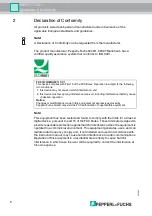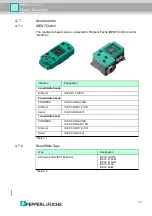
IUH-F117-V1-*
Product Description
20
13
-0
4
13
To work with unique number sequences without having to use sometimes
expensive EPC codes, we recommend using the TID of the tag, which is
programmed into the tag chips by the semiconductor manufacturer.
4.2.7
Influence of various materials on the sensing range
In the UHF range, the nature of the surrounding area and the surface to which the
transponder is secured have a serious influence on the range that the system can
attain. The UHF transponder cannot be mounted on metal without requiring
adaptations. Glass has a negative influence on the sensing range when used as a
mounting surface. If a UHF transponder is mounted on damp material, the
sensing range is much poorer than the range of a transponder mounted on dry
material. The mounting surface often affects the read range much more than the
material between the transponder and the read/write head. The graph shows the
effect of different materials on the sensing range.
4.2.8
Dense Reader Mode (DRM)
A special operating mode for read/write tags in accordance with the specification
EPC Gen 2 (ISO/IEC 18000-63) allows several read/write heads to be operated
close to each other simultaneously without interference.
Europe
In accordance with EN 302208, only channels 4, 7, 10, and 13 are used in this
mode for transmission with the read/write head (read/write head -> read/write tag
communication path). The transmitting power is a maximum of 2 W
erp
.
0 %
10 %
20 %
30 %
40 %
50 %
60 %
70 %
80 %
90 %
100 %
Material
underground
Material between transponder and
read / write head
Foam material
Film
Cardboard (dry)
Cardboard (wet)
Wood (dry)
Glass
Metal
Ai
r
Film
Ca
rd
boar
d
(dr
y)
C
ar
db
oar
d
(w
et)
Wo
od
(d
ry
)
Foam
material
Glas
s
Me
tal














































